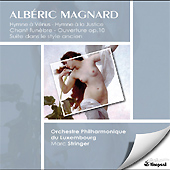
ESSENTIAL RECORDINGS

When this recording was first released back in 2002, I quickly dismissed it (probably because my listening interests lay elsewhere at the time) and never gave it a second chance. Bad mistake! Very bad mistake! It has now been given a second lease on life with this 2009 re-issue, and this time around I have given it my full attention and strongly recommend that you do the same.
Albéric Magnard (1865-1914) has sometimes been given the moniker of the "French Bruckner" and by some the "French Schumann". To me the Bruckner comparison makes no sense, and the Schumann is an understatement. I myself see Albéric Magnard more as a "French Brahms", and although he lived at pretty well exactly the same time as Gustav Mahler, the two could not have perceived music more differently. His writing style and structural form are based on a strong Germanic tradition, but his harmonic writing is where he stands apart and is what forms the backbone of his music. He studied music under Massenet, D'indy and Théodore Dubois, who himself had written a strong thesis on harmony, which explains Magnard's solid grasp of the matter. Most of his works display a keen manipulation of a natural harmonic progression from start to finish, favoring an economy of gestures and loud statements, and simply letting the innate harmonic flow dictate the music's direction, but with such a solid command of form, that everything fits in a neat little package. In Magnard's hands, less is more.
To me, the hidden jewel on this CD is the Chant Funèbre, written after the death of his father in 1894. The main focus of the work revolves around a descending three note motif, much resembling the tolling of bells, described as the 'knell' motif, which flows in and out of the orchestral fabric to great effect. Although its instrumental garb changes a few times throughout the piece, it always remains the dominant voice over the sombre, processional rhythmic flow of the orchestra. The magic in the writing is demonstrated by the fact that even though that three note motif never really changes, it progressively becomes brighter and leads the way to a transcendant and light filled coda.
As far as I can tell, this is the only available recording of all these shorter orchestral works of Magnard gathered together on one CD. Don't make the same mistake I did.
Get yourself a copy before it's too late and it gets taken off the market.
Jean-Yves Duperron